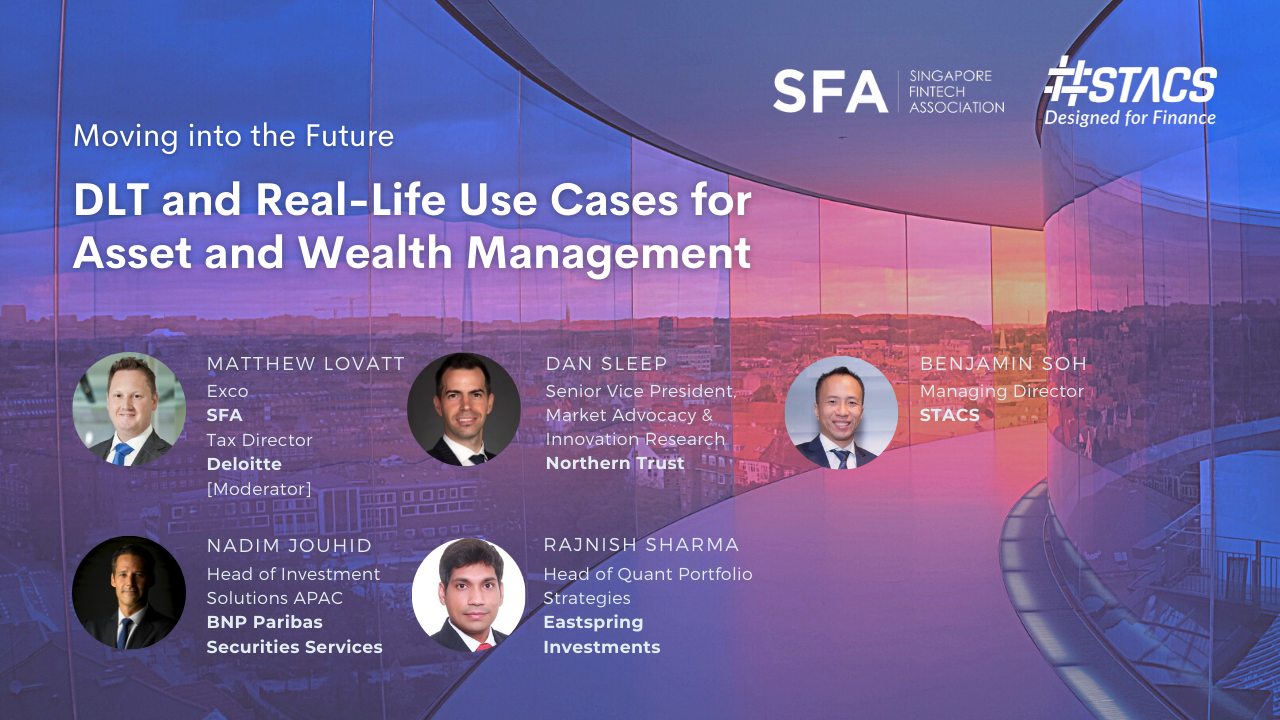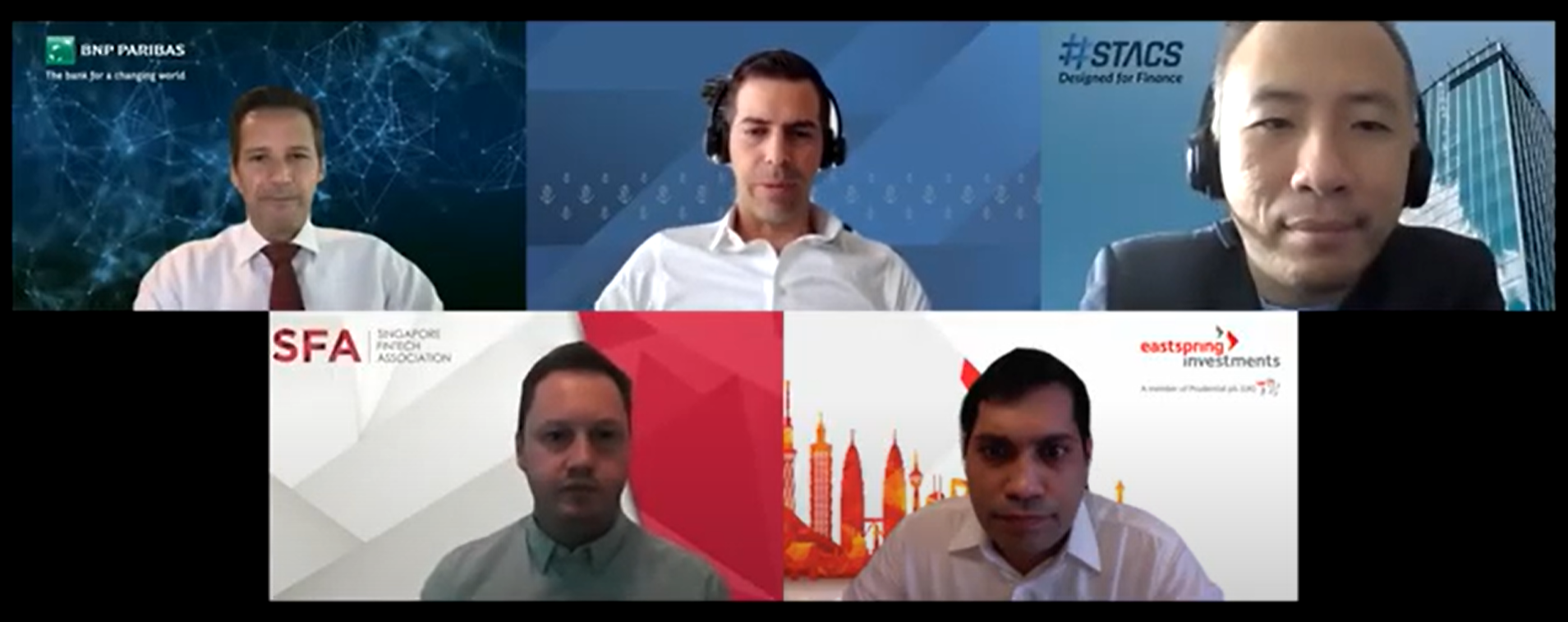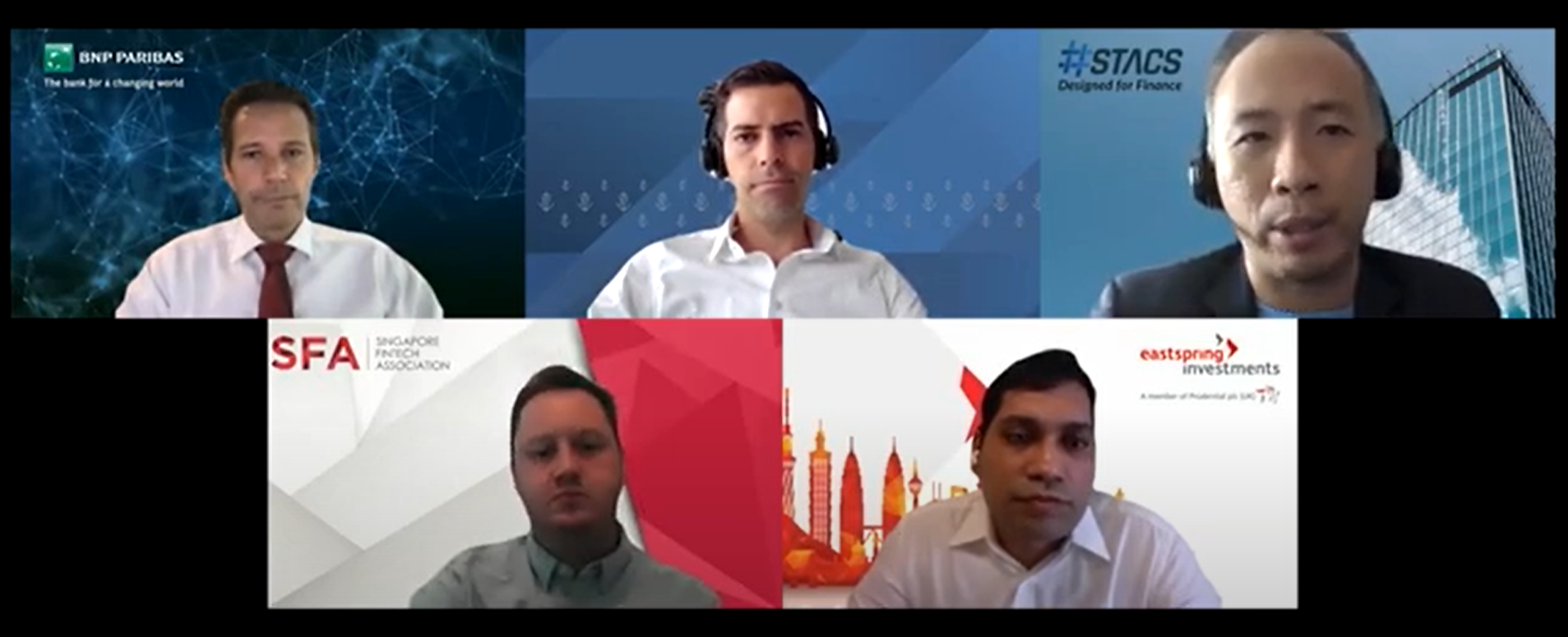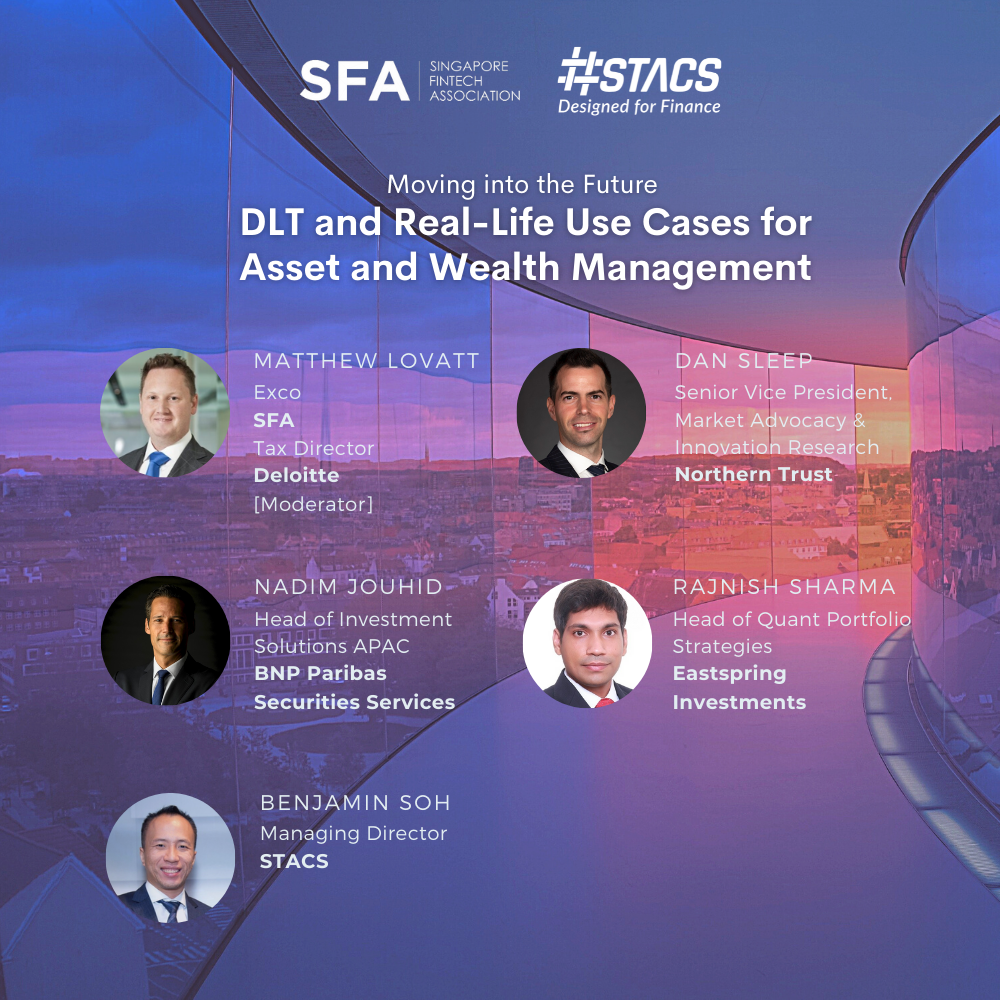DLT and Real-Life Use Cases for Asset and Wealth Management – Industry Panel by STACS and the Singapore FinTech Association (SFA), with Northern Trust, BNP Paribas Securities Services, and Eastspring Investments

DLT and Real-Life Use Cases for Asset and Wealth Management on 30 September
What are some of the milestones and macro trends that distributed ledger technology (DLT) has embarked on in the asset and wealth management space? What are some of the business challenges that DLT is facing, and how could DLT be the potential fix to these business challenges?
Those were some of the topics discussed by a panel of leading industry leaders brought together by the Singapore FinTech Association (SFA) and us — Singapore fintech firm STACS.
From real-time trade processing to same day clearing, ESG fintech, and impact monitoring, the panel dived deep into how global leading asset managers, banks, and middle office providers are working with fintechs on real-life DLT deployments and collaborations. The goal, of course, is to empower financial institutions and the wider ecosystem.
The session was moderated by Matthew Lovatt, Exco at Singapore FinTech Association (SFA) and Tax Director at Deloitte. Speakers included our very own Benjamin Soh, Managing Director at STACS; Dan Sleep, Senior Vice President of Market Advocacy & Innovation Research at Northern Trust Corporation; Nadim Jouhid, Head of Investment Solutions APAC at BNP Paribas Securities Services; and Rajnish Sharma, Head of Quant Portfolio Strategies at Eastspring Investments.

Speakers: (Top Left to Bottom Right): Nadim Jouhid (BNP Paribas), Dan Sleep (Northern Trust), Benjamin Soh (STACS), Moderator – Matthew Lovatt (SFA), and Rajnish Sharma (EastSpring Investments).
Watch the full panel here.
Read on below for some of the key takeaways Benjamin shared during the discussion.
An US $800 billion problem
We founded STACS two years ago, at a time when we had a few industry veterans from the financial sector, as well as fintech entrepreneurs like myself, coming together to form a company. The basic premise was to try to provide newer technologies given that over the last 50 years the world of financial markets hasn’t really changed.
We are still using traditional legacy infrastructure on the B2B side across financial operations. Many people are now using mobile banking at train stations and applications that let you trade practically anything, anywhere. Still, the real issues lie within the behind-the-scenes processes or the plumbing that still exists between financial institutions.
That has really not changed in the last 50 years since the DTTCC began with their model of CSD clearing in 1973. Back then, the market was many times smaller than it is today — capital markets have grown multiple folds since. Even so, it’s a fact that US$800 billion is still locked up every single day just in the processes of linear dependent processing (i.e. for trade clearing and settlement).
Fixing trade breaks and fails
We started thinking: why can’t we use newer technologies to fill this gap? Why are we going to accept US$800 billion locked up every day when it’s not even an effective use of capital for markets. Moreover, 6 per cent of trades still fail to settle on average. This all leads to billions of dollars in penalties being paid by institutions — and billions more in losses from wrong trades, wrong allocations, wrong reconciliations, and wrong settlements.
Those were the problems that we were facing when we started STACS two years ago. Since then, we’re pleased to say that with the help of many participants, veterans, and experts we have been able to develop and deploy a DLT-based platform that overcomes some of these issues.
Going back to the premise of the company, we felt that as a distributed ledger we could allow for multiple participants to be on the same platform handling transactions in a concurrent fashion, instead of being stuck in a linear-dependent process. Instead of having a reconciliation executed in two days, we are now able to execute it immediately.
Settlements are still flexible (be that T+1 or T+2) but at least institutions now have the confidence that when they settle a trade on a DLT platform it is correct and final. With the use of smart contracts, we will be able to bring great benefits to the financial services industry.
We take a holistic and long term approach when integrating sustainability into our investment process. What does this mean? It means that we not only look at environmental issues, but we balance it with what that means for financial issues or financial costs, and social issues that affect the company and the community that the company operates in. We also look at climate risks from all aspects, not focusing just on transition risks but also fiscal risks.
And finally, when thinking about addressing climate change in our portfolio, we take a holistic approach to integrate climate change considerations at all levels of our investment decision making. We see climate change really as a material investment risk that investors need to manage. It affects investments through three broad channels: physical risk, transmission risk, and market risk.
The first two are very familiar to many of us so I will not go into details. More information can be found on our website, where we publish our thoughts on these topics. But I want to highlight market risk as an impact channel because it is not commonly discussed. And there are two effects here. First is whether markets will price in future climate-related risks via transition rates or physical risk into market pricing today. Second is whether markets will overreact when they start pricing in future climate related risks.
Starting with specific applications
When the panelists all mentioned the targeting of specific parts of the transaction lifecycle instead of everything in one go, it was something that we at STACS resonated with. Often it’s easier to approach a deployment in that way, as it allows both sides to pick up quick wins and then scale up further after testing certain use cases.
At STACS, our job is to make such transitions as painless as possible for the institutions we work with, who we definitely need to work together with as partners and collaborators. While we are trying to provide new technology, let me be clear that we are not trying to uproot the traditional models of financial markets.
Some of our real world experiences, particularly with global leading institutions like BNP Paribas and Eastspring, have involved co-development of the various solutions targeted at very specific pain points. Those are the sort of projects that we find meaningful, rather than us trying to build something and wait for the institutions to come to us. We are working closely with them to identify the pain points, to do the design thinking, to do ideation, and ultimately to go to market together.

Instituitions are coming to us now
This whole approach is something that I hadn’t really seen before in an earlier era of financial services. Of course, in the early days of our life as a company we had to do some market education and advocacy of DLT. But recently, especially in the last few months, we realised that institutions are increasingly coming to us with goals in mind.
They often have a vision of what they want to achieve and very clear propositions around how they think DLT can help them. So in that sense, it’s becoming much easier. As a technology firm, our job is to help institutions bridge this transition from old ways of working to better implementations and interoperability using the blockchain.
If executed well, it shouldn’t even affect the daily lives of the end professionals using the systems (in that the technology is beneath the surface and mostly invisible). DLT is a new technology and the fact that we haven’t solved these trade reconciliation problems for the last 10 years ago is mostly because the technology wasn’t widely available until now.
Putting a Singapore VCC on the blockchain
This gives us great encouragement and we are optimistic about the potential to further scale up to new asset classes and tackle other sections of the financial value chain. For example, just recently (30 September 2021), we announced in a joint press release that we were involved in a project where the Singapore VCC (variable capital company) structure was tokenised and put on the blockchain.
We at STACS were selected as the private blockchain protocol provider in the project led by InvestaX, UBS, State Street, and CMS, with our infrastructure being used to tokenise funds. Through this Proof-of-Concept that was awarded the Financial Sector Technology and Innovation (FSTI) grant by the Monetary Authority of Singapore (MAS), industry participants were able to determine the lifecycle and workflow processes for efficiencies gained using an e-VCC, and in particular, where the use of DLT could enable new market opportunities and operating models.
So, beyond just trade processing, which is where we started as a company, we are now thinking about expanding into new areas and starting to identify propositions such as creating a fund on the DLT.
Structuring a Singapore VCC requires quite a lot of work, from subscriptions and redemptions to reporting and fund admin — all of this is very manual today. It requires a lot of man hours and sometimes manual errors creep in. Automating some of these processes using the DLT is what we’ve successfully done in this proof of concept (POC) along with InvestaX, UBS, and State Street. We are now hoping to extend the functionality even further over time.
Tackling climate change with blockchain
MAS announced Project Greenprint a few months back during the talk about creating a green financial center. They talked about providing support for industry-wide solutions. While many financial institutions are having scenario analyses of various types of climate science models, we have to make sure that the data is correct in the first place.
Otherwise, there will be a lot of impact on the conclusions being arrived at. For example, insurance companies can go broke if they are insuring in the wrong way, especially when climate is changing over the next 20 years. That’s where the need here is to make sure that the data is being captured correctly at the project level.
We are talking about 15,000 companies in Singapore, so we’re not going to do that overnight. But we have a better chance if we use technology rather than manual inputs. In Singapore alone there are 28,000 buildings across commercial and industrial. Putting aside residential buildings, there are 28,000 offices, malls, warehouses, etc.
ESG project certification in real time
Yet there are only 22 certification providers, with each provider typically having one or two partners who can do it very professionally. Typically, they will take more than one month to certify a building — so if we do the math correctly it’s basically impossible for them to certify all the buildings in Singapore within our lifetime. We therefore need to think about how we can use technology to get this done.
Beyond blockchain, we need to combine efforts with partners in data analytics, data acquisition technologies, IoT, and more in order to capture the raw data of projects and then aggregate that into entity data. We have started doing work with the transport and logistics sector, for example, and are already tracking some of the corporate fleets in Singapore.
By using new technologies, we can build out streams of real-time ‘continuous data’ that is verifiable. That will in turn empower more financial institutions (asset managers, banks or even insurers) who are making financing and risk management decisions to have a complete picture when it comes to ESG. That’s one very clear use case of DLT in conjunction with other emerging technologies that we’re excited about.
We would like to thank the Singapore FinTech Association (SFA) for co-hosting this successful event, and the distinguished speakers — Matthew, Dan, Nadim, and Rajnish, for sharing your valuable insights and expertise with us.
PRESS CONTACTS
If you are a journalist with media queries, contact us.




